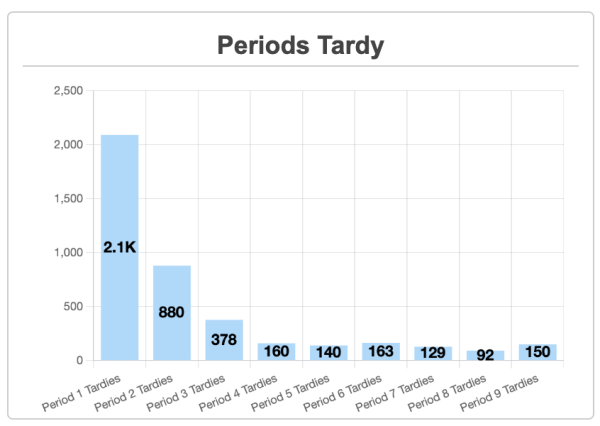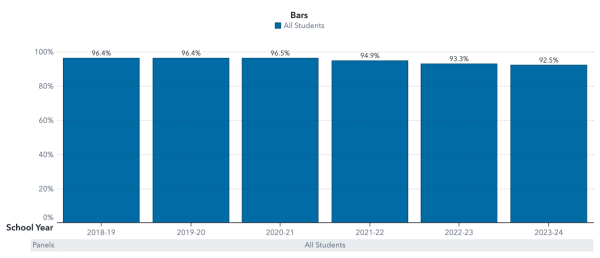
Logo for Student Attendance Policy Changes at OSHS
School administrators recently announced that beginning next year students of Old Saybrook High School will be subject to new attendance regulations. These will involve much stricter consequences, and come after a string of different plans and attempts by administrators to combat the severe decline in student attendance seen in recent years did not create the change they had hoped to see. Associate Principal David Plotkin has become the voice for this cause, reaching out to teachers and students to find the most effective way to deal with this issue. He says, “we value our students, and we can’t work magic if they’re not here.”
The regulations, new to today’s students, are actually from a policy last in full effect at OSHS in 2011 and phased out ever since. s rules were changed, discipline became more relaxed, and as a result, student attendance day-to-day significantly declined, according to Plotkin. Plotkin explained, “when a student has reached 16 total absences for a full year course, or eight total absences for a semester course, the credit for that course will be withheld from that student pending an appeal through the appeals process.” This doesn’t just cover full absences, as the policy also specifies that every fifth tardy counts as an absence and will go toward the threshold, which could mean a student takes a course and receives no credit for it. However, the appeal is a vital part of this process, allowing students a chance to explain their actions and maintain that credit despite chronic absenteeism. Plotkin explained that to appeal, “there is a form that students will fill out which includes basic information like your name and grade, and they must also provide an explanation of the extenuating circumstances that has impacted your attendance to the course, attaching any documentation which can support the appeal.” Extenuating circumstances can be anything from doctors visits to court appearances, which is all listed by the State of Connecticut as reason for an absence to be excused. It is also specified by the State that only the listed reasons available for view on their website can qualify as extenuating circumstances, and thus excused absences, after the first nine absences. Prior to nine, any reason accompanied by parent or guardian approval will be excused.
Such a seemingly drastic change in policy may come as a surprise to many students, but as Plotkin found stepping into his role of associate principal three years ago, many people, teachers and students alike, have found attendance to be a distinct issue for quite a while, apparent in statistics showing numbers like 4,200 tardies for students this year alone. He tried several methods that didn’t have enough impact, leading to conversations with neighboring high schools in the shoreline conference. What may come as an even bigger surprise to students, he said, “it turned out we were the only high school in the area that did not tie attendance to the credit of a course.” This news, combined with statistics that show a decline of average daily student attendance from 96.5% in the 2020 to 2021 school year to 92.5% in the 2023 to 2024 school year showed a need for change. As for what he thinks will be the biggest challenge for students, Plotkin detailed, “they may not realize how quickly they’re going to get to 16 or eight [absences]. It will also probably be surprising how quickly tardies can add up and start to have an impact.” This may be true, as data from this school year, 2024 to 2025, shows that if these new attendance regulations had been in place, a total of 40 students would have been at the point of losing credit in a course, only nine of which would have likely been approved on appeal, Plotkin explained.
Students often argue that there are many assignments they can do without being present in class, and continue to maintain good grades. Plotkin recognized the truth in that statement, but he said, “there’s more to school than just completing an assignment and turning it in. There’s the social aspects and the relationship building … the types of things you can’t engage in unless you’re here just being a member of the building.” As this is not a new policy, next year is not a pilot, nothing is being tested out, and the administration does not see these regulations as something that will be going away any time soon. Plotkin has good hope for the effect that this will have in creating change at OSHS, and he says, “the message is simple that we want you to attend, we want you to engage, and when you do those things, you will excel.”
If a regulation was in place for the 2023 – 2024 school year where a student with 18+ absences would lose credit for a full year course…
Number of students with 18+ Absences who earned credit in a course or courses
Of those students, number who would have likely been approved via appeal
Total number of students who would have likely lost credit in a course or courses despite an appeal
40
9
31
OSHS Current Year Tardy Data (Through 05/07/25)

